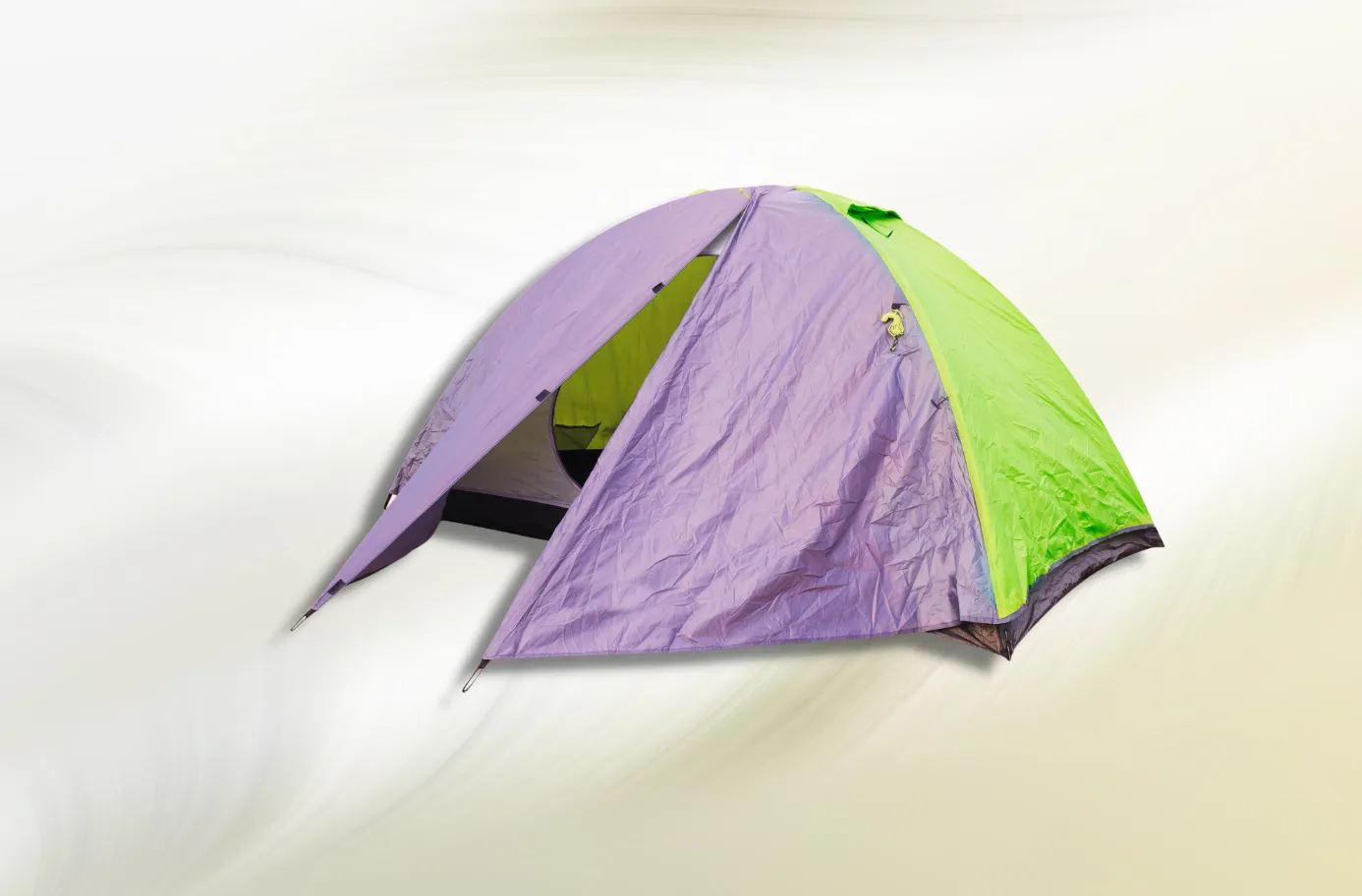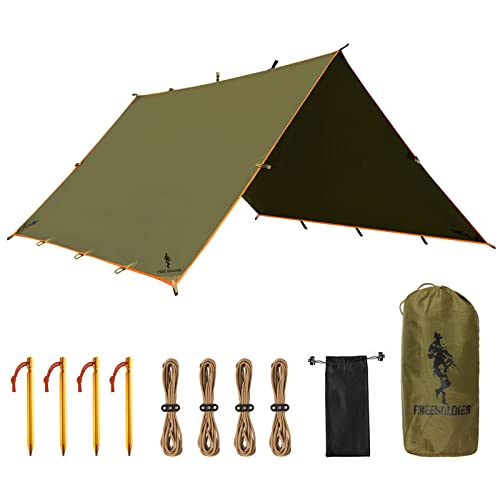Camping exposes you to the elements much more directly than spending the night in a lakeside cabin or a mountain lodge.
The question of how to maximize your warmth in the outdoors depends on a wide variety of factors. No one wants to set up camp, get in their sleeping bag, and realize that they are vastly unprepared to make it through the night without shivering.
One useful tool that many campers overlook is the tarp, a great first line of defense against water, cold temperatures, and discomfort as you cozy up for the night.
Tarps keep your tent warm. The two most common types are rain tarps and ground tarps. Both retain warmth in slightly different ways. Rain tarps protect from bad weather and assist in tent ventilation. Ground tarps provide a barrier between you and the ground, ensuring minimal loss of body heat.
Table of Contents
Rain Tarps
- WATERPROOF & UV PROTECTION - Hammock Camping Tarp made of 210T ripstop polyester...
- STRONG & STABLE - This Camping Awnings using heat sealing and melting process,...
- HEAVY DUTY & PORTABLE - Large size in 118" × 126" when expended, enough for 2...
- ACCESSORIES & SIMPLE TO OPERATE - Comes with everything of survival backpacking...
- QUALITY GUARANTEES - FREE SOLDIER Waterproof Portable Tarp apply to heavy duty...
Rain tarps, commonly referred to as “rainflys,” are plastic or canvas covers for your tent. They insulate the tent body and protect from water entering your tent. They almost always come with a tent set.
Their main purpose is to act as a physical barrier between the mesh top of your tent and any possible rainfall. If rain gets in your tent, you will certainly be wetter and colder than if you block it with a tarp. On a dry night it may be tempting to sleep with an open ceiling to see the stars, but the rain tarp’s secondary function, insulation, is often vital to a good night’s sleep.
Rain tarps hold warmth in your tent by blocking wind. They cover any openings in the tent body, preventing cold air from rushing through and chilling the overall temperature. Staying warm while camping relies on trapping as much body heat as you can inside of your tent. If you’ve ever woken up in late morning on a camping trip to direct sunlight on your tent, you know that a good rain tarp quickly turns your tent into an oven in the daytime, blocking any possibility of a cooling breeze.
Although you want the rain tarp to cover your tent and trap heat inside at night, it is also important to ventilate your tent in a few spots.
Typically, rain tarps that come with tents have vent openings. It may seem counterintuitive, but when you fully seal yourself in a tent there is nowhere for the air you exhale to escape into the atmosphere. When your breath cannot reach the outside of the tent, it turns to water vapor inside of the tent, causing humidity in your tent and damp surfaces.
A dry tent is a warm tent. Aside from being generally unpleasant, wet tents also greatly reduce your capacity to stay warm, as wet cold air feels much colder than dry cold air. But a rain tarp often needs some assistance in keeping your tent completely free of water. This is where ground tarps come into play.
Ground Tarps
- DURABLE: REDCAMP waterproof tarp is made from 210T ripstop polyester fabric that...
- LARGE: 210x220cm/83x87", perfect for 3-4 person. You can place the camp ground...
- MULTIPURPOSE TENT TARP FOR UNDER TENT: The outdoor tent footprint is ideal for a...
- LIGHTWEIGHT AND COMPACT: Ultralight tarp only weighs: 0.85lbs/386g, package...
- 100% MONEY BACK GUARANTEE: REDCAMP offers a 365-day full manufacturer warranty....
Ground tarps are commonly made of polyethylene and vary in thickness, depending on your preferences and where you purchase them from. They do not usually come with a tent set but are available at outdoor retailers and hardware stores. REI refers to its collection of ground tarps as “footprints,” which are specially designed to fit underneath their line of tents. Many outdoors companies have their own variations of the trusty ground tarp that are suited to their style and size of tent.
To choose a ground tarp, you should consider what kind of trip you will be using it for, then select a tarp that makes sense in terms of weight and bulk.
When placed underneath a tent, a ground tarp functions as a strong layer of insulation—it physically blocks you from sleeping directly on a thin tent floor on the ground. The closer your body is to the ground, the more heat will escape as you sleep.
To stay warm in a tent, campers should opt for multiple layers between their bodies and the ground. A ground tarp is a good base, creating a first line of defense against the cold ground and setting up a slightly warmer surface to set the rest of your gear on for the night.
A ground tarp also prevents punctures in your tent and lessens the amount of mud and water that could enter in the event of a storm. If you camp with your tent floor directly on the ground, there is a greater chance that water could find its way in, which should be avoided at all costs.
Other Important Factors
While ground and rain tarps are both key components of a warm night in a tent, there are a few more variables you should consider to maximize your warmth.
First, the size of your tent matters. If you opt for a large tent, there is a lot more open space for your body heat to escape. To stay the warmest, you should always try to use a tent that was designed for the number of occupants on your trip.
Second, a good sleeping pad adds another strong layer of insulation between you and the ground. There are many options in the market today for sleeping pads. Self-inflating pads, blow-up pads, and foam pads all get the job done–your choice is a matter of personal preference and comfort.
A general rule of thumb is that thicker pads offer more insulation, as they are further off the ground. Although, some pads are made with more insulating materials than others, so thickness is not the only determining factor.
Lastly, choosing the right sleeping bag and using it correctly can make a large difference in your warmth overnight in a tent. Sleeping bags generally have a temperature window they were designed for (e.g. 29-35°), which gives you an idea as to what will work for the area you are choosing to camp. To maximize warmth, you should always zip the bag completely, trapping as much body heat as possible.
Whether you’re a seasoned backpacker or are trying out car camping for the first time, a combination of multiple types of insulation is key to success in staying warm. Protecting your body from ground temperature, winds, and water ensures that you will not have to work as hard to keep your body heat and get a good night’s sleep.

Alex Mwangi is the creator of Outdoor Right and an outdoor enthusiast. During his free time he enjoys riding his road bike or traveling the world looking for his next adventure.



